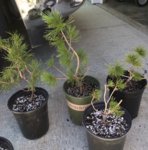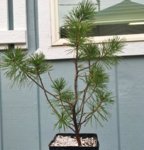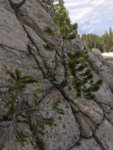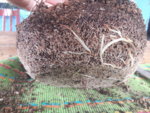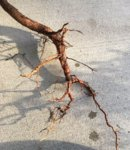SPRING COLLECTING
I want to start this thread early enough so that I can be ready for spring collecting in the mountains very close to where I live. My home town is at 3435 ft and I collected last spring at 5000-7500 ft well before there was any growth or budding showing on the collected trees. Most of the time I collected in leftover winter snow. I collected lodge pole pines, ponderosa pines, a few 5 needle pines, spruces, larches and a couple of Rocky Mt maples. Specimens were collected in the forest and under canopies of mature trees, so they did not have a lot of direct sunlight during the days. Also, they were probably covered with snow all winter. My success rate was not great in my opinion even though I tried very hard to do what I thought was right in the collection process. The blue spruce and Rocky Mt maple, Ponderosa pine and larch success was very good…it was the lodge pole and the 5 needle pines that I had trouble with. I collected specimens from 6” to 30” and most of the bigger ones did not make it through the summer. Some of the smaller ones didn’t either. The Lodgepole pines are very numerous and easily collected. Their root system consists of a tap root with some sturdy offshoots from that with very few small feeder roots. Sometimes I trimmed about 10-20% off the tap root. The native soil was mostly sandy/rocky so it was hard to retain soil around the roots when collecting. I would dig specimens, put them in native soil in pots up on the mountain, bring them home, remove them from the native soil mixture and quickly plant them in a grow pot using a mixture of a good grade of potting soil (no fertilizer), added a big % of the perlite/pumice, and a little diatomaceous earth for water retention. Most were bare rooted in the transfer process, but never allowed to dry out at all. I then kept them in an area that got early morning sun only and they were watered as needed in the well-drained soil. No fertilizer until I saw growth starting. Nothing died immediately, but through the summer a number of them had needles browning and then I would see that dry, green/gray ghost look to the needles before they went South. I did NOT note on tags which trees I had clipped the tap roots on or at what elevation they were dug, but I will this year. After thinking about my loses last spring and summer, I wonder if digging at 5000-7500 ft and bringing them down to 3400 ft could cause a problem. Maybe I should dig them, plant them in a grow pot on the mt in native soil, put the whole thing back in the ground and leave them there for a month or two and then bring them down. Maybe my mixture in the grow pots needs improvement. Maybe digging anything over 14-18” is not a good idea. Maybe there is a special solution that I should be watering with that would help the survival rate. Maybe I should leave them in the native soil for a year or two.
Another thing I wonder about is digging in the fall verses digging in the spring. I have planted a lot of shrubs and trees in the fall and always had good luck with them if they are kept moist. It just seems to me that collecting in the fall after some freezes, and the sap is down, and the trees are in a dormant stage would be a lot easier on the collected specimens verses collecting in the spring, changing elevations, changing soils, disturbing the root systems etc, etc, and then expecting the trees to survive the summer weather (think warm/hot summers).
I have attached some pictures of some specimens collected last spring.
Any advice, knowledge or help would be appreciated. Thanks, Peter
I want to start this thread early enough so that I can be ready for spring collecting in the mountains very close to where I live. My home town is at 3435 ft and I collected last spring at 5000-7500 ft well before there was any growth or budding showing on the collected trees. Most of the time I collected in leftover winter snow. I collected lodge pole pines, ponderosa pines, a few 5 needle pines, spruces, larches and a couple of Rocky Mt maples. Specimens were collected in the forest and under canopies of mature trees, so they did not have a lot of direct sunlight during the days. Also, they were probably covered with snow all winter. My success rate was not great in my opinion even though I tried very hard to do what I thought was right in the collection process. The blue spruce and Rocky Mt maple, Ponderosa pine and larch success was very good…it was the lodge pole and the 5 needle pines that I had trouble with. I collected specimens from 6” to 30” and most of the bigger ones did not make it through the summer. Some of the smaller ones didn’t either. The Lodgepole pines are very numerous and easily collected. Their root system consists of a tap root with some sturdy offshoots from that with very few small feeder roots. Sometimes I trimmed about 10-20% off the tap root. The native soil was mostly sandy/rocky so it was hard to retain soil around the roots when collecting. I would dig specimens, put them in native soil in pots up on the mountain, bring them home, remove them from the native soil mixture and quickly plant them in a grow pot using a mixture of a good grade of potting soil (no fertilizer), added a big % of the perlite/pumice, and a little diatomaceous earth for water retention. Most were bare rooted in the transfer process, but never allowed to dry out at all. I then kept them in an area that got early morning sun only and they were watered as needed in the well-drained soil. No fertilizer until I saw growth starting. Nothing died immediately, but through the summer a number of them had needles browning and then I would see that dry, green/gray ghost look to the needles before they went South. I did NOT note on tags which trees I had clipped the tap roots on or at what elevation they were dug, but I will this year. After thinking about my loses last spring and summer, I wonder if digging at 5000-7500 ft and bringing them down to 3400 ft could cause a problem. Maybe I should dig them, plant them in a grow pot on the mt in native soil, put the whole thing back in the ground and leave them there for a month or two and then bring them down. Maybe my mixture in the grow pots needs improvement. Maybe digging anything over 14-18” is not a good idea. Maybe there is a special solution that I should be watering with that would help the survival rate. Maybe I should leave them in the native soil for a year or two.
Another thing I wonder about is digging in the fall verses digging in the spring. I have planted a lot of shrubs and trees in the fall and always had good luck with them if they are kept moist. It just seems to me that collecting in the fall after some freezes, and the sap is down, and the trees are in a dormant stage would be a lot easier on the collected specimens verses collecting in the spring, changing elevations, changing soils, disturbing the root systems etc, etc, and then expecting the trees to survive the summer weather (think warm/hot summers).
I have attached some pictures of some specimens collected last spring.
Any advice, knowledge or help would be appreciated. Thanks, Peter


